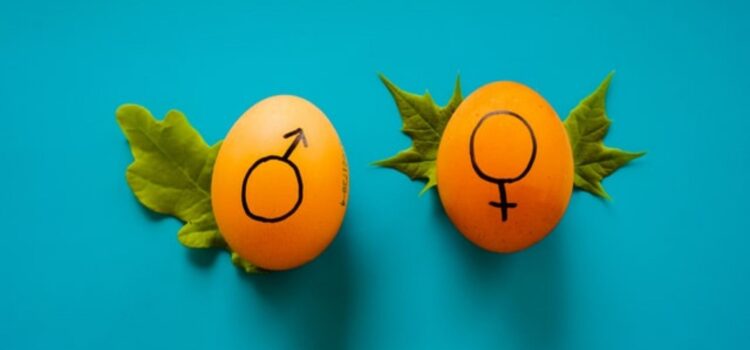

This article is an excerpt from the Shortform book guide to "Come As You Are" by Emily Nagoski. Shortform has the world's best summaries and analyses of books you should be reading.
Like this article? Sign up for a free trial here .
What is the difference between the male and female reproductive systems? How do these differences develop?
Both men’s and women’s genitalia have the same origins, stemming from the same embryonic tissue. However, these organs ultimately develop in unique ways, take distinct shapes, and serve different functions depending on a person’s sex.
Let’s explore the differences between male and female anatomy.
Female Genitalia and Their Male Counterparts
In her book Come as You Are, Emily Nagoski asserts that we can better understand the identical origins but different functions of men’s and women’s homologous genitalia by examining the differences between male and female anatomy. Although she provides various comparisons, we’ll limit our discussion to just two crucial sets of organs.
Clitoris vs. Penis
According to Nagoski, the clitoris is the anatomical source of female sexual pleasure. The visible part is right below where the inner labia or “lips” of the vulva (i.e. external parts of the female genitalia) meet, although it extends far inside a woman’s body.
(Shortform note: The fact that Nagoski points out the true size and shape of the clitoris is important, as many people don’t realize just how far it extends into the body. In fact, it took until 1981 for any health body to create an anatomically correct diagram of the clitoris, and many school textbooks don’t even mention this organ, let alone explain its true size and shape. This persistent misinformation and misconception support her argument for the need for a biological understanding of female genitalia.)
The male equivalent of the clitoris is the penis, Nagoski notes. Just like the clitoris, the penis is the sexual pleasure center and is positioned front and center on the body. However, whereas only the head of the clitoris is visible outside of a woman’s body, the head and half the length of the entire penis is visible outside of a man’s body. Nagoski argues that their differences in appearance have everything to do with their differences in function. Whereas the clitoris is only responsible for sensation, the penis is responsible for sensation, penetration, ejaculation, and urination.
(Shortform note: Nagoski doesn’t elaborate on why these differences in function lead to differences in appearance. The penis must extend further than the clitoris as it must be long enough to penetrate and ejaculate into the vaginal canal, which is inside a woman’s body.)
Outer Labia vs. Scrotum
Nagoski explains that the outer labia, or “lips,” are fleshy and hairy folds of skin around the vaginal opening. (Shortform note: The function of the outer labia is to protect the vagina—and therefore internal organs connected to the vagina like the ovaries, urethra, and clitoris—from damage.)
The male counterpart of the outer labia is the scrotum, which is the fleshy and hairy bag of skin hanging below the penis that holds the testicles. Nagoski notes that upon close inspection, you can see the seam on the scrotum where it would have split into outer labia had the embryo been female. (Shortform note: Just as the outer labia serve to protect some of the most vital sexual organs, the scrotum acts as a layer of protection for the testicles, which are the organs that produce sperm.)
(Shortform note: Why must the scrotum extend further out from the body than the outer labia? Nagoski doesn’t explore this, but it’s because the scrotum must keep the testicles cooler than the internal body temperature to produce sperm. On the other hand, the ovaries—which are the female equivalent of the testicles and produce eggs and hormones—don’t require the same environmental conditions to function. Because of this, they’re located inside the body rather than externally with the outer labia.)
The Variation in Female Genitalia
Nagoski tells us that just as men and women have similar parts organized in different ways, female genitalia, too, can vary a lot from woman to woman. In particular, she notes that the size, shape, and even color of everything from the clitoris to the labia can differ greatly depending on the person. Understanding this from a biological perspective can help women realize that whatever the unique appearance of their genitalia, they’re normal and healthy.
(Shortform note: While Nagoski specifically mentions women here, men have a lot of genital variation too. For instance, the penis and scrotum can differ in size, shape, and color in much the same way as female genitalia. What’s more, men also face feelings of shame about the appearance of their genitals—for instance, the size of their penis—that stem from a toxic and pervasive standard for what it means to be masculine.)

———End of Preview———
Like what you just read? Read the rest of the world's best book summary and analysis of Emily Nagoski's "Come As You Are" at Shortform .
Here's what you'll find in our full Come As You Are summary :
- Why women should change the way they talk, think, and feel about their sexuality
- A look at the misinformation and harmful cultural messaging surrounding sex
- A discussion around the individual experiences of arousal, desire, and orgasm






